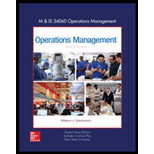
Concept explainers
Two independent methods of

a. Compute the MSE and MAD for each forecast. Does either forecast seem superior? Explain.
b. Compute MAPE for each forecast.
c. Prepare a naive forecast for periods 2 through 11 using the given sales data Compute each of the following: (1) MSE, (2) MAD, (3) tracking signal at month 10, and (4) 2s control limits How do the naive results compare with the other two forecasts?
a)
To compare: The MAD and MSE for two forecasts given below, including actual sales for 10 months.
Introduction: Mean Absolute Deviation (MAD) is the average distance between the data values and the mean. Mean Squared Error (MSE) is the average of the squares of the deviation and error.
Explanation of Solution
Given information:
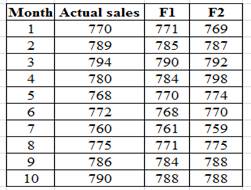
Compute the MAD and MSE as shown below in the table:
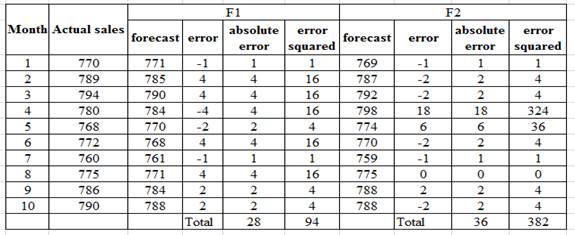
Compute the Mean absolute deviation (MAD) for the forecasting method F1 as shown below
Substitute the value of
Compute the Mean squared error (MSE) for the forecasting method F1 as shown below
Substitute the value of
Compute the Mean absolute deviation (MAD) for the forecasting method F2 as shown below
Substitute the value of
Compute the Mean squared error (MSE) for the forecasting method F2 as shown below
Substitute the value of
The first forecasting method F1 gives both a low value of MAD as well as MSE compared to the second forecasting method F2
b)
To compute: Mean Absolute Percentage Error for both the forecasts F1 and F2 as shown below.
Introduction: Forecasting is the planning process that helps to predict the future demand using present or past data. It uses certain assumptions based the knowledge and experience of the management.
Explanation of Solution
Determine MAPE for both the forecasts:
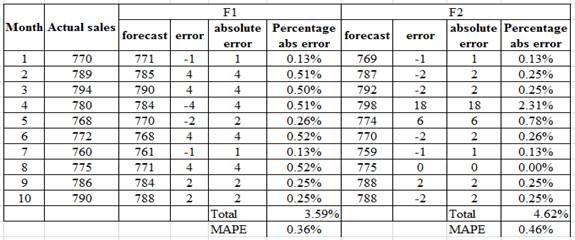
The Mean absolute percentage error is lower at 0.36% for the first forecasting method F1 compared to MAPE of 0.46% for the second forecasting method F2
c)
To prepare: A naïve forecast.
Introduction: Forecasting is the planning process that helps to predict the future demand using present or past data. It uses certain assumptions based the knowledge and experience of the management.
Explanation of Solution
Determine MAD and MSE using a naïve forecast:
Use the naïve method for forecasting as shown below.
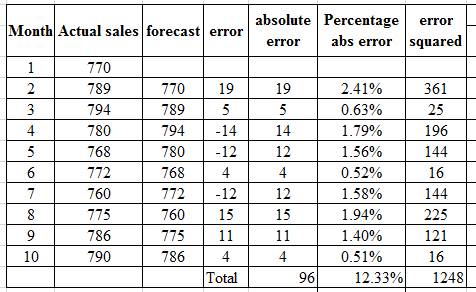
(i)
Compute the Mean absolute deviation (MAD) for the naïve forecasting method as shown below
Substitute the value of
(ii)
Compute the Mean squared error (MSE) for the naïve forecasting method as shown below
Substitute the value of
(iii)
Compute the tracking signal on the 10th month as shown below.
First compute the cumulative forecast error (CFE) as shown below
12.49=
Compute the tracking signal (TS) by dividing the cumulative forecast error by MAD as shown below.
(iv)
Given the Mean Squared Error is 156, the standard deviation σ is 12.49
The two sigma control limits are +2×12.49=24.98 and -2×12.49=–24.98
Since the tracking signal 1.87 falls between +24.98 and –24.98, the forecasting process is in control
The comparison of the naïve method with the other two forecasting methods is shown below.

Obviously the naïve method compares very poorly with the other two methods F1 and F2, since both the Mean Absolute Deviation (MAD) and Mean Squared Error (MSE) are worse than the other two methods.
Want to see more full solutions like this?
Chapter 3 Solutions
OPERATIONS MANAGEMENT W/ CNCT+
- Analyse the impact of integrating EDI (Electronic Data Interchange) with API (Application Programming Interface) on supply chain management, particularly focusing on how this integration enhances information flow and operational efficiency. Consider the challenges that might arise from this integration in terms of managing legacy systems alongside modern applications.arrow_forward1) View the video What is Operations Management (14.01 minutes, Ctrl+Click on the link); what are your key takeaways (tie to one or more of the topics discussed in Chapters 1 and/or 2) after watching this video. (https://www.viddler.com/embed/d01189e1) Note: As a rough guideline, please try to keep the written submission to one or two paragraphs. 2) View the video What McDonald’s is serving up at its new CosMc’s Chain (3.42 mins, Ctrl+Click in the link), and answer the following questions: (https://www.youtube.com/watch?v=k7ojpUzE8q4) i) From a strategic perspective, why do you think McDonald’s is opting for this new chain rather than trying to launch the new menu in its existing restaurants? ii) What factors do you think in McDonald’s external and internal environments are driving its decision to open the CosMc’s locations? iii) How do you think this format will improve McDonald’s profit margin as compared to its regular fast-food restaurants? Note: As a…arrow_forwardSince the end of World War II, globalization has steadily increased with rapid expansion around the turn of the 21st century. What are some of the forces driving globalization and international business? What are some of the challenges of engaging in international business compared to doing business in your home country?arrow_forward
- PS.53 Brother I.D. Ricks is a faculty member at BYU-Idaho whose grandchildren live in Oklahoma and California. He and his wife would like to visit their grandchildren at least once a year in these states. They currently have one vehicle with well over 100,000 miles on it, so they want to buy a newer vehicle with fewer miles and that gets better gas mileage. They are considering two options: (1) a new subcompact car that would cost $18,750 to purchase or (2) a used sedan that would cost $12,750.They anticipate that the new subcompact would get 37 miles per gallon (combined highway and around town driving) while the sedan would get 26 miles per gallon. Based on their road tripping history they expect to drive 13,000 miles per year. For the purposes of their analysis they are assuming that gas will cost $2.93 per gallon.Question: How many miles would the Ricks need to drive before the cost of these two options would be the same? (Display your answer to the nearest whole number.) (Hint:…arrow_forwardChoose one major approach to job design, and then discuss how best that approach can be utilized in either your current or previous employer, including a discussion of its strengths and weaknesses.arrow_forwardThe results of your four plans will provide an indicative EOQ value. State this value and discuss in a precise manner, why it is not the exact, true value. Additional calculations in the form of plans E, F etc. may also assist your explanation of the EOQ and can be includedarrow_forward
- i). Complete the table assuming a Level production plan. ii) Comment on your results and explain whether at this stage, you consider a Level plan is a suitable approach for this particular business. Your comment should include reference to a calculated ‘fill rate’.arrow_forwardIn the following sawtooth inventory profile diagram, two inventory plans with different order quantities (Q) and different frequencies of delivery are shown; order quantity for Plan A = 200 units and Plan B = 50 units. i). Total demand (D) is 350 units, the holding cost per unit (Ch) is equal to (£0.8) and the ordering cost per order (Co) is (£12.5). Calculate the total costs for each plan and state which one is more preferable along with the reason why. ii). There is a stark difference in the composition of the total costs of Plans A and B. Explain this difference and why it occurs. Use the breakdown of costs for each plan to help illustrate your answer.arrow_forwardi). Complete the table for a Chase production plan. ii). Explain whether a Level or Chase plan is more suitable for the demand pattern experienced by this particular business, which incidentally relies on highly skilled workers in the production process. Assume a starting workforce of 7 and that fractional workers are permissible. You should support your answer with numerical data derived from Table 3. In comparing the costs, state any other assumptions made.arrow_forward
- i). Complete for a Chase production plan. ii). Explain whether a Level or Chase plan is more suitable for the demand pattern experienced by this particular business, which incidentally relies on highly skilled workers in the production process. Assume a starting workforce of 7 and that fractional workers are permissible.arrow_forwardComplete the table for a Chase production plan.arrow_forwardHow much can the garden centre expect to sell during each quarter of next year (Year 3) accounting for seasonality? Your forecast must make use of seasonal indices. All workings must be shown in full. (NOTE: Please round your calculations to three decimal places).arrow_forward
 Contemporary MarketingMarketingISBN:9780357033777Author:Louis E. Boone, David L. KurtzPublisher:Cengage LearningMarketingMarketingISBN:9780357033791Author:Pride, William MPublisher:South Western Educational Publishing
Contemporary MarketingMarketingISBN:9780357033777Author:Louis E. Boone, David L. KurtzPublisher:Cengage LearningMarketingMarketingISBN:9780357033791Author:Pride, William MPublisher:South Western Educational Publishing Practical Management ScienceOperations ManagementISBN:9781337406659Author:WINSTON, Wayne L.Publisher:Cengage,
Practical Management ScienceOperations ManagementISBN:9781337406659Author:WINSTON, Wayne L.Publisher:Cengage, Purchasing and Supply Chain ManagementOperations ManagementISBN:9781285869681Author:Robert M. Monczka, Robert B. Handfield, Larry C. Giunipero, James L. PattersonPublisher:Cengage Learning
Purchasing and Supply Chain ManagementOperations ManagementISBN:9781285869681Author:Robert M. Monczka, Robert B. Handfield, Larry C. Giunipero, James L. PattersonPublisher:Cengage Learning



